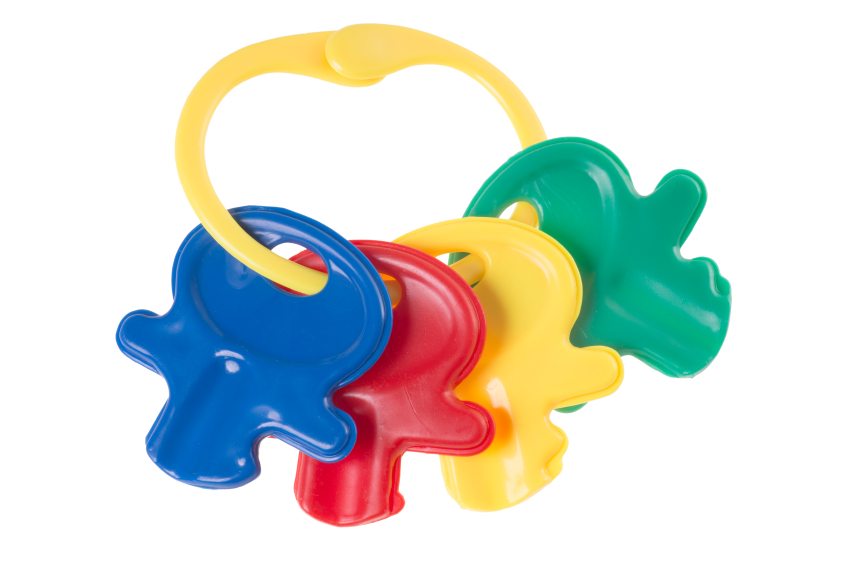Teethers are devices designed to be chewed on by infants during the teething period, providing relief and helping emerging baby teeth to break through the gum tissue. Teething rings and other teething toys are typically made of soft plastics, rubber, silicone, or even wood. Some types are simple, solid devices, while others incorporate a liquid or gel-filled inner compartment. While the benefits of teethers are, in principle, widely accepted, some models may pose serious health risks to infants, such as choking, infection, and even poisoning.
It is not uncommon for infants to suffer during the teething period, as baby teeth push through the gums; the pain can make babies irritable and prevent their sleeping properly, and the need for relief urges them to chew on thumbs, fingers, or whatever objects they can manage to put in the mouth. While this behaviour is normal and assists the teething process, it can have undesirable consequences: smaller objects may be swallowed, potentially causing the baby to choke, sharp or rugged objects can cause lesions, and dirty objects can introduce microbes or parasites.
Teethers are usually excellent at safely being chewed on all day long. Firm, solid teethers are generally considered safer than fluid-filled models, as they are less likely to break. If a teether does break, detached fragments can pose a risk of choking; check the state of your baby’s teethers frequently, and replace them periodically, even if they appear to be in decent shape. Resilience is not, however, the only consideration; there is also concern over potentially harmful substances that may be released in unsafe doses by sucking and chewing on some baby products.
The use of soft PVC (Polyvinyl Chloride) plastics for the manufacturing of teethers and other child care products or toys is currently highly controversial, as it contains phthalates, compounds which may constitute risk factors for cancer, infertility, and liver conditions. The use of some phthalate additives in baby products and children’s toys that can be sucked or chewed has been restricted in many countries, notably in the European Union and the United States. Such measures, however, are being contested by some experts and plastic industry representatives.
The FDA (US Food and Drug Administration) expresses concern over the possible effects of BPA (bisphenol A), a compound frequently found in plastics. While experimental data on humans is still inconclusive, studies on animals have linked BPA with several conditions, mainly brain and behaviour issues, heart problems, cancer, and hormonal disturbances; children may be particularly vulnerable. It is still unknown just how much BPA can actually be absorbed through chewing and sucking on plastic sources, but the compound is gradually being phased out of use in most child care products.
In the case of liquid-filled teething rings, a common problem is that damage can lead to fluid leaks; while the liquid is usually a harmless saline solution or plain water, it may be contaminated with harmful bacteria. In 2006, the FDA cautioned the public against using certain liquid-filled teething ring models, on account of possible microbial contamination. If you opt for a fluid-filled teething ring, look for strong, durable materials; if the liquid or gel contains any pharmaceutically active compounds, such as analgesics, get your paediatrician’s advice before using it.
Analgesic teething gels should only be used at the paediatrician’s recommendation. The AAP (American Academy of Paediatrics) maintains that using cold objects, such as cooled teething rings, is the safest way to alleviate gum discomfort and pain during the teething period. Be warned, however, that teethers should only be cooled in the refrigerator, and never placed in the freezer; frozen teething rings can damage the gums and cause more pain than relief. Also, if you are using liquid-filled teething rings, freezing the liquid may cause the outer shell to crack.
Keeping teethers clean is an important aspect or early oral hygiene, as your baby is likely to drop them on the ground every now and then. Simply wiping and replacing the dirty object in your child’s mouth is not an ideal solution; you should wash it with water and soap or equivalent cleaning agents, or keep a clean, spare teether on hand when away from home. Also, using your own mouth to clean the teether is not advisable, as saliva is a carrier for plaque microbes which can damage your baby’s teeth.
Infants need to suck and chew, and teethers are specifically designed to provide a safer and more effective alternative to thumbs and miscellaneous objects. Unfortunately, some types may expose young children to various health risks, owing to design faults, subpar quality, improper usage, or potentially harmful chemical composition. Nevertheless, choosing a safe product for your child is both possible and useful; asking your dentist or paediatrician for advice is always a good idea, as it may help prevent unwanted complications.

